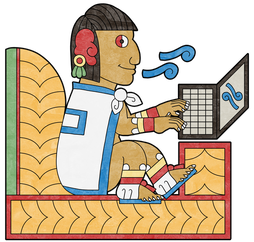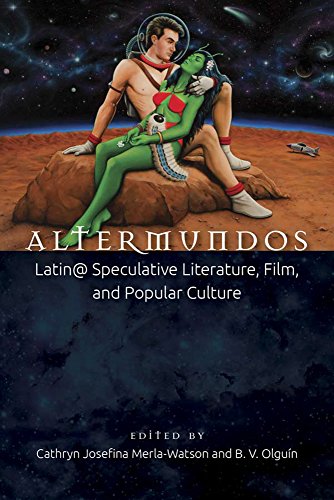Charge up your dilithium crystals!  By Scott Duncan-Fernandez Any brand spanking new robot may require batteries. For a first of its kind book to package literary, media, and cultural criticism about Latino speculative fiction, Altermundos would generate much more of a charge with some knowledge of Chicano Studies and issues. Most importantly, though, Altermundos elevates a genre to its worthy place of criticism, which has been ignored as low culture or critiqued (or, disdained) as art despite its speculative roots. While Altermundos calls itself and at times adheres to “Latino sci-fi,” it sticks mostly with us Chicanos, and of course, mostly speculative works: Chicanofuturism, Chicano sci-fi, and Chicano literature and culture. Not only does Altermundos give a fresh look at some classic Chicano work with a new speculative lens, it brings forward many works of Latino sci-fi, fantasy, and horror that have been in the periphery. Latin@ Rising (Wings Press, 2017), (reviewed here in Somos en escrito, under the title, “¿Qué hay en la bolsa?”) gave us a look at the present and future of US Latino speculative fiction; Altermundos validates our past and with its many essays discussing issues ranging from feminist, queer, social, post-colonial and social justice gives us a future to look forward to. Since I began this review earlier in 2018 and set it down, there have been many Latin Scifi happenings, here on Somos en escrito as well. The Mexicanx Collective has…collected into a group of Mexican sci-fi writers. Her Body and Other Parties by Carmen Machado is being made into a movie. The second volume of Latin@ Rising, now called The Latinx Archives, and a new printing of the original is in the works. (I have a couple of flash stories that will be included there). The Extra-fiction contest at Somos en escrito had its first winner in Rudy Ch. Garcia and received many other fine work with an extra something. I keep seeing more and more sci-fi flavored (some a pinch, some a cup) novels and stories by our communities floating up from the depths of the periphery. Batteries required for those not up to light-speed. I love reading literary criticism and especially those works dealing with US Latino and speculative fiction, so of course, I’m right in the crux of the demographic of their audience. That said, I’m concerned that those who like literary criticism in general won’t take this as seriously because it deals with speculative works. The fact is that this book enhances and reinvigorates Chicano literary analysis. This is a fresh onda bigger and better than the one my fellow Texan ran away from so quickly in that mess of a movie, Interstellar. Altermundos is 80 percent literary/media criticism, 10 percent personal essay, and 10 percent fiction or poetry. Like literary fiction and poetry, literary criticism is a discussion and it’s a bit difficult to jump in and nod like you know what’s going on. While many may be up to speed, for those interested in sci-fi and lack a basis in Chicanismo, they may need a little help. If you are in the opposite camp, you may find, as Altermundos makes a case for, sci-fi elements floating in the pozole of Mexican American literature. An important work to know in general and for the criticism presented often in Altermundos is Borderlands by Gloria Anzaldúa. Quotes from it are spread throughout, as well as quotes from her interviews. Her book opens its arms to mestizaje, and advocates for a new kind of mestizo-mindedness that includes gender as well, which comes up in many Altermundos essays. Anzaldúa clearly applies Post-Colonial and Queer theories in terms of identity and mestizaje to the crossroad of selfhoods that our experience entails. Another book is Chicano Manifesto. While not discussed in Altermundos, it remains to this day the best book to know issues of Chicano society, history, and identity, and one many other books build upon. (Disclosure: our own editor, Armando Rendón is the author.) Many books offer a background on Chicano literary theory, including Chicano literature itself. The two overlap more in the Chicano realm than in the standard American realm as they often deal with issues of identity and history, Drink Cultura by Jose Antonio Burciaga, for an example. Yet,Borderlands and Chicano Manifesto are the ones to help anyone get up to speed forAltermundos. A few terms of note Altermundos: Spaces, grounded in realities that look toward utopian and decolonial futures. Alter-native: an outlook with Neo-Native eyes. Rascuache/Rasquache: You know what it is if you’re a Mexican American. It’s your grandparents’ back yard full of recycled and repurposed and redecorated objects. It’s what happens when teenage boys in the 50s see Anglo teens get new cars and then fix up their own lemons with style into ranflas. It’s doing a lot with a little and with style. It’s mentioned every other word in nearly every essay: this pocho will never forget rascuache again. CSP: Chicano Speculative Production. Something made by a Chicano and speculative in whatever media. Chicanafuturism: Inspired by Afrofuturism, it’s the way the use of technology transforms Chicano life and culture. While Afrofuturism often deals with diaspora, Chicanafuturism often deals with the post-colonial. Nepantla: Nahuatl word meaning “in the middle,” being caught between the dominant culture and one’s state of origin, which is used to connote the state of in-between in the Chicano experience. Nepantlera: Portmanteaux of the Nahuatl word nepantla and Spanish -era, someone who exists in Nepantla. Praxis: implementing ideas or theories. An important concern for social justice. Chicanonautica: A Chicano speculative traveler that trespasses to new frontiers. A term coined by the father of Chicano sci-fi, Ernest Hogan. Selections of Work Many Chicano Speculative Productions lie on the periphery, but a few pieces reviewed are more fringe than others. I expected the movie Paranormal Activity: The Marked Ones with its Chicano Hardy Boys and Nancy Drews taken over by the demons they investigate to make an appearance or have a mention. I look it up and the only thing Latin about the movie were its actors and setting. When it comes to films, this calls into questions what is a CSP, as often films taken or marketed as CSPs are Anglo written, produced, and directed by non Mexican Americans. The much beloved and recent Coco is in that category. We are not always the ones defining our very existence. It seems Altermundos has chosen movies with Latin directors such as Machete and Sleep Dealer and avoided movies that may not exactly fit the bill. Some of the story choices for review are somewhat recondite. Finding “Refugio,” for example, took a little searching. It’s a short story included in Night Bites: Vampire Stories by Women Tales of Blood and Lust (1996). It isn’t listed under the work on the author’s site and the Amazon page doesn’t list her name as included in the anthology. Granted, it took me ten minutes rather than ten seconds, but in this information age, that’s an eternity. “Refugio” is an excellent story, recondite or not, and I’m glad to have been introduced to Terri de la Pena’s work. This kind of thing, the finding of interesting work new to you, is what anthologies are about. List of works that come up often throughout Altermundos: Sleep Dealer Alex Rivera, film Love and Rockets Jaime Hernandez, comic Los Vendidos (the sellouts) Luis Valdez, play Lunar Braceros Rosaura Sanchez and Beatrice Pita, novel Smoking Mirror Blues Ernest Hogan, novel The Ragdoll Plagues Alejandro Morales, novel The work of Guillermo Gómez-Peña The work of Gloria Anzaldúa  Serendipity in the periphery After finding and reading/viewing/listening to most of the work critiqued or mentioned inAltermundos (I had read a few before and a few others had been on my radar), I found that many of these works come from the periphery. Though sci-fi and fantasy are booming—just look at how superhero movies have become big blockbusters rather than underfunded or fan made over the last two decades--our Latino works are still ignored, pushing in at the corners, or thought of as lessor, especially the Mexican American, southwest variety. Reading these fine works, which are somewhat forgotten or hidden, is distressing: The Ragdoll Plagues has great prose. Smoking Mirror Blues is like Neuromancer or Strange Days got lowered and fitted with hydraulics and a paint job of an Aztec temple on its hood. In other words, something well written and fresh that should have been a movie by now. These and the other works in Altermundos are deserving of the critical storms that they can weather. Like the quantum telescope, the critical eye of scholars changes them: it elevates the Chicano Speculative Projects and brings them into much needed attention. It’s about time. We Latinos need these stories where we are not the villain. Where our eyes are not forced to participate in a ritual that reinforces our subjugation and the view of ourselves as monstrous natives, mestizos, afro-mestizos, or rival Spaniards. CSPs are not Avatar or Alien Covenant. That is, our stories don’t portray obvious retellings of westward invasion to achieve dominance over everything to tell us who we are. We are the actors and we are humans in these works, and sometimes more than human.  Retconning Many essays aim to recast or “retcon” all of Chicano literature as a speculative production. I agree…mostly. Like any idea, it fits here and not there. Like Ernest Hogan says, “…Chicano is a science fiction state of being.” We are mixed, we don’t fit in a culture that throws aspects of the monstrous upon us. This causes many CSPs to ask, “¿Oye, what kind of mutant are you?” This does give a new, refreshing point of view, but it’s also something that may be over applied. Imagination and the imagination of belonging may be speculative, but is Jane Eyrespeculative? I know that’s an old British book and not Mexican American, but it’s one where a female character imagines (literally in some places) her identity and a world in which she can have more agency. Many Chicano literary works and media also seem to deal with pure, uncut reality and sometimes they point to a future of inter-reliance and over-coming that isn’t here yet, something that isn’t always super-duper speculative. In other words, don’t get no F on su tarea, kids, for saying The Squatter and The Don is puro sci-fi. Speculative isn’t always robots, zombies, and aliens, but there is a little over-reaching here. Some Highlights “Poison Men: A Chicana Vampire Tale” Provided as an example of what a feminist Chicana vampire tale can be, Linda Heidenreich includes this original work in the essay “Colonial Past, Utopian Futures.” It’s the first time I’ve seen fiction about Josepha, the woman who was the first recorded Chicana lynched in California under US rule. Josepha killed a man who violently broke into her and her boyfriend’s home. The lynch mob hanged her and her last words were to ask that her body be given to her friends. Josepha has been mentioned in passing in histories, often incorrectly and dismissively as Juana. In the story, Heidenreich offers that Josepha is a vampire. Healed after her hanging, she finds a cabal of older vampires to learn from, to spend centuries on learning. Heidenreich argues for a better kind of vampire tale, a tale of sexualized other that doesn’t have to end in a type of control—marriage, death, or sexual passivity. A point and example for all of us to ponder, especially us straight male writers about our portrayals. I love this salvaging and empowering of our stories and historical figures. Machete Yes, Machete gets his own section. Essays on Machete could have taken up the entire book, but he only gets one. Danny Trejo’s cool character (I’m not a fan obviously) brings much together: resistance, folk traditions, and science-fiction. The topic discussed toward the end I found the most interesting: How Machete inhabits a folk hero position (in a “whatever works” manner) and how like the corridos of old, such as those of Juan Cortina, Joaquin Murrieta, and Tiburcio Vasquez, he unifies voices of Mexican American identity and resistance. I might even add, camp. Chicanos are nothing if not humorous, and humor is a great weapon against naked emperors. “For those seeking signs of intelligent life” by Deborah Kueztzpal Vasquez An enjoyable short story (memoir?) where the narrator shares her intergalactic origins and upbringing via her mothers. As a boy, I, too, heard how my sister and I were star people from our mother; at times we believed and other times we laughed. The narrator takes a trip to the motherland in the sky and how we all can be there if we erase hate and materialism from our hearts and how governments have twisted extraterrestrial knowledge and how we can do better if…. I like that Altermundos includes a few fiction pieces. In “For Those Seeking Signs of Intelligent Life,” there is social critique, a new-old way of being, a method to resolve trauma and to see the world. Not only a good story, but something that exemplifies the many purposes CSPs may bring to the table on critiques and necessary information to living one’s life as an indigenous person and/or a person inhabiting many crossroads of ethnicity, nations, and gender. The author’s artwork is likewise excellent and adds to the story and allows the viewer to wonder out on their own personal rocket ship to the space gods. “Strange Leaves” is an excellent story – it’s being described as horror caused me to question what horror is. I would classify it as a crime-thriller as it deals with a character coming across a victim of assault while crossing over into Texas, the “strange leaves” are the victim’s clothes on a bush. Body-horror and the use of technology make me wonder, does horror have to have an element of the supernatural, as I normally view it? Whatever you may call it, it’s a good story that brings attention to an important issue of assault of innocent women crossing over. “Chicanonautica Manifesto” by Ernest Hogan Ernest Hogan, his own work often the subject of critique in Altermundos, puts many of the ideas expressed in the other essays succinctly, informally, and wonderfully. “Probably because Chicano is a science fiction state of being. We exist between cultures, and our existence creates new cultures: rasquache mash-ups of what we experience across borders and in barrios all over the planet. We mestizos have no sense of cultural purity. Mariachis on Mars? Seems natural to me.” Speaking of personal essays, “Flying Saucers in the Barrio,” which is about the Speculative Rock opera put on by high school Chicanos in the 70s, recounted by the teacher, Gregg Barrios, who wrote the play, is an amazing piece of history. The play is inspired and includes the music of David Bowie albums such as The Rise and Fall of Ziggy Stardust and the Spiders from Mars. In the play, the Starman, the “alien” as a Chicano doesn’t fit and isn’t welcome. The essay is an interesting and well written bit of reflection on early speculative Chicano work and a snapshot of a moment in the Chicano Movement. Los Planes de Alterlandias (ala Plan de Santa Barbara, de Aztlan, etc.) Most Chicano work, literature and media give tools for life or validation. Often include poetry, resolving of identity, social critique, and a view or a plan. Some essays in Altermundosoffer plans and a list to ways forward. Others, like the short story, “For those seeking signs of intelligent life,” offer an example of what could be, a speculative existence you could live now if you tried. This is the vision of a human, Chicano-centered space that many of the works critiqued in Altermundos get at. A science-fiction of our own personhood that may be the future, ret-conned past, or the now. The plans, the lists of concerns, the call to actions, all are speculative. They are speculative praxis, they are meant to be implemented to create a future or a future self. Several Altermundosarticles have plans for social justice, e.g., “Decolonizing the Future Today: Speculative Testimonios and Neplantlerx Futurism in Student Activism,” by Natalia Deeb-Sossa and Susy J. Zepeda. Chicano CSPs are formative and speculative. I said this first book of Latino Speculative Criticism is necessary…because we can discover and look deeply at how we portray the world in which we are human. To see how necessary this is, you don’t need to go farther than my desk: I’m only a little ashamed to say I have desk toys. Many people are familiar with the issues for Mexican American children have in the US finding positive representation in media. Being a non-fluent Spanglish speaker I’ve always been acutely aware of any brown representation in the mainstream of US science fiction, especially as a child. While it is common for the man-children of my generation to collect figurines and toys from science fiction and fantasy, I realized when I collected Mexican action figures that it was filling an old gap from childhood. While not a creative act per se, collecting figures is, as the many authors in Altermundos put it, something I can look over and imagine a world where we are human. In short, Altermundos is an excellent selection of criticism that would allow anyone to know the Mexican American experience better, but there needs to be Altermundos Dos and anAltermundos Planetas de Jovenes. We need more anthologies and more venues.  Scott Russell Duncan, a.k.a. Scott Duncan-Fernandez, recently completed The Ramona Diary of SRD, a memoir of growing up Chicano-Anglo and a fantastical tour reclaiming the myths of Spanish California. Scott’s fiction involves the mythic, the surreal, the abstract, in other words, the weird. Scott received his MFA from Mills College in Oakland, California where he now lives and writes. He is an assistant editor at Somos en escrito. See more about his work and publications on Scott’s website scottrussellduncan.com.
0 Comments
|
Archives
June 2024
Categories
All
|
Donate and Make Literature Happen
is published by the Somos En Escrito Literary Foundation,
a 501 (c) (3) non-profit, tax-exempt corporation. EIN 81-3162209





 RSS Feed
RSS Feed